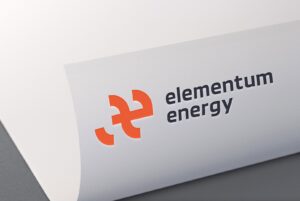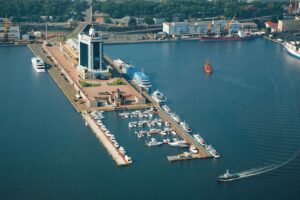
Elementum Energy, a subsidiary of VR Capital Group operating in the renewable energy sector, plans to launch the 60 MW Dunay wind farm in the south of the Odesa region by the end of 2026, according to Olga Rybachuk, managing director of Elementum Energy and member of the board of the Ukrainian Wind Energy Association.
“We have already started construction and activated the turbine contract with Vestas. They are already being manufactured, all permits are in place, and the site is being completed. We hope that the wind farm will be connected to the grid by the end of 2026,” Rybachuk said at the UWEA’s final press conference at the Interfax-Ukraine agency on December 19.
In addition, according to her, the company has already reached the final stage of development of a 200 MW wind farm project in western Ukraine.
“This project should be ready for construction to begin in the first quarter of next year. We are very actively considering starting its construction in the second quarter of 2026,” Rybachuk said.
At the same time, she drew attention to the need for legislative regulation of one of the issues related to connecting new generation facilities to Ukrenergo substations, namely, providing investors with the opportunity to build the necessary facilities for such connection themselves.
“The construction and reconstruction of Ukrenergo substations for connection is an extremely long process, taking 2-3 years, which no project can afford. If we can independently answer to NEC for organizing the construction process, conducting our own tenders, and selecting contractors, then this project will fit into the construction timeframe of 1.5-2 years. This is what the power system needs, and it is very suitable in terms of resources and economic effects,” explained the managing director of Elementum Energy.
She stressed that making the appropriate amendments to the legislation is a critical issue.
“We very much hope that by 2028, the 200 MW wind farm will be supplying energy to Ukraine’s power grid,” Rybachuk emphasized.
As for the turbine manufacturer, she said that the company will most likely choose between Vestas and Nordex.
“In addition, we are working with the World Bank Group, IFC, which is very interested in financing Elementum projects and supports us in developing projects for sale on the open market, without any form of state support. The investment in this project is large, more than EUR 300 million. I agree that it cannot be done without financial partners. And, fortunately for us, we have a very powerful financial partner,” said the top manager of Elementum Energy.
Rybachuk also noted that the company plans to implement a pilot project for a 10 MW energy storage facility (ESF) with a capacity of 20 MWh, which it wants to build near one of its wind farms to test the joint operation of generation and ESF.
“We plan to see our ESS in operation by mid-2026. When we started this project, we were counting on our own funds, but soon the World Bank joined with a grant,” she said.
The company’s chosen operational model of WPP+ESS does not provide ancillary services to the transmission system operator, but rather involves working in time-shifted energy transfer modes, dealing with imbalances and constraints.
“In principle, storage systems should become an integral part of all new wind and solar projects because they minimize the specific component of renewable sources—imbalances,” the top manager believes.
At the same time, Rybachuk emphasized that the transmission system operator and distribution system operators limit renewable energy producers to 30-40% of their installed capacity at certain times.
“I think we cannot afford this, we cannot lose megawatts to restrictions,” she said, noting that resolving issues related to the operation of the UZE will also be a priority for the UEA in 2026.
According to her, the UZE has already been delivered to the site, and its assembly and connection will begin later this year.
As reported, at the same press conference, the chairman of the board of the Ukrainian Wind Energy Association (WEA), Andriy Konechenkov, noted that since the beginning of 2025, 324 MW of new wind power capacity has been built in Ukraine, while in the previous two years – between 2022 and the first quarter of 2025 – 248 MW of new wind power capacity was commissioned.
The country also has 534 MW of total installed capacity of energy storage systems (BESS).
Elementum Energy is an international investor in Ukraine’s renewable energy sector. The company manages a portfolio of solar and wind power plants with a total capacity of 636 MW and continues to develop new projects in the field of wind energy and energy storage systems.
In early December 2024, Elementum Energy announced that it had acquired a 200 MW wind power project in western Ukraine and intends to prepare it for construction in late 2025.

In January-November 2025, Ukraine exported 118.62 thousand tons of eggs in shells, which is 66.6% more than in the same period of 2024, according to the State Customs Service.
According to published statistics, in monetary terms, egg exports increased 2.7 times, to $183.37 million, compared to $67.14 million a year ago.
The top three buyers of Ukrainian eggs were Spain, which accounted for 17.9% of exports of this product, or $32.76 million in monetary terms, the United Kingdom – 14% and $25.69 million, respectively, and the Czech Republic – 11.6% and $21.19 million. Last year, Israel led the way in purchasing Ukrainian eggs, accounting for 14.8% of exports worth $9.91 million, followed by Poland with 11.9% worth $8 million and Italy with 11.1% worth $7.46 million.
Ukraine’s egg imports during the reporting period increased by 18.4% to 9.53 thousand tons, bringing in $54.36 million in monetary terms, which is 48.3% more than in the same period last year.
The leaders in egg supplies to Ukraine during the reporting period of 2025, as in 2024, were the Netherlands (41.4% and 46.3% of imported volumes, respectively), the Czech Republic (28.9% and 24.2%), and Germany (13.9% and 18.5%).
Exports of shelled eggs in the first 11 months of this year decreased by 5.3% to 6.64 thousand tons, while cash proceeds from their sale increased by 26.5% compared to the same period in 2024, to $38.54 million. The main buyers of domestic egg products were Italy (32.5%), Poland (29%), and Denmark (16.8%).
Imports of this product in January-November 2025 amounted to 58 tons, compared to 105 tons a year ago. Suppliers of shelled eggs this year included France (80.7%), Sweden (18.8%), and Poland (0.6%), while in 2024 they were France (85.2%), Sweden (10.9%), and Austria (3.7%).

The difficult situation in the ports of Odessa and logistics problems are limiting activity in the oilseed sector in Ukraine, according to the information and analytical agency APK-Inform.
“Russian army missile attacks on Ukrainian ports, damage to terminals, warehouses, and other infrastructure will cause a reduction in shipments in the coming months and may destabilize the situation on the global agricultural market,” analysts explained.
They noted that last week, price growth on the Ukrainian soybean export market stalled, which was due to both missile attacks on ports and pressure from the global market, despite the fact that demand for Ukrainian soybeans remained quite high and export rates grew in the first half of December.
Experts added that demand prices for GM soybeans in Ukrainian ports remained at their highest levels since August 2024 – $420-425 per ton (CPT port).
“The European Union has finally postponed the implementation of the EUDR regulation for another year, which will allow companies to increase supplies of soybeans and soybean meal in this direction,” APK-Inform predicts.

In January-November 2025, Ukraine imported 44.18 thousand tons of coffee and 10.21 thousand tons of tea, which is 0.6% and 13.3% less than in the same period of 2024, according to the State Customs Service.
According to published statistics, in monetary terms, coffee imports increased by 39.2% to $352.18 million compared to $252.97 million for the same period a year earlier.
The main suppliers of coffee to Ukraine in the first 11 months of this year were Poland, which accounted for 15.5% of imports, or $54.67 million in monetary terms, Germany – 13.1% and $46.24 million, and Italy – 11.9% and $41.86 million.
A year earlier, the top three coffee suppliers to Ukraine for the corresponding period remained unchanged, except for their share in supplies: Poland (16.2%, $41.07 million), Italy (15.3%, $38.63 million), and Germany (13.1%, $33.09 million).
Tea imports during January-November 2025 decreased by 11.9% in monetary terms, to $38.92 million, compared to $44.19 million last year.
At the same time, the top three tea suppliers to Ukraine for the first 11 months of this year remained unchanged: Sri Lanka (30.3% or $11.8 million), Kenya (17.6% or $6.86 million), and China (12.5% or $4.85 million). Last year, these countries accounted for 31.6%, 20.1%, and 10.8% of the market, with tea supplies to Ukraine bringing them $13.96 million, $8.87 million, and $4.791 million, respectively.

Deputy Minister of Education and Science Mykola Trofimenko expects that after the war ends, the number of foreign students in Ukraine may grow to 100,000.
“Today, our universities combine many areas of study, including those that are important for society, such as resilience. Europeans cannot understand this. And this, by the way, is one of the factors that will contribute to an increase in the number of foreigners after the war ends. Because now we have 20,000 foreigners studying here, and before the full-scale war there were about 80,000. The goal is to recover after the war ends to 100,000 foreign students,” Trofimenko said in an exclusive interview with the Interfax-Ukraine news agency.
He stressed that everything must be done to ensure that our universities maintain this network of contacts and their ability to teach foreigners.
“And after the war ends, we will see a significant recovery in the number of foreign citizens who will receive education at our Ukrainian universities,” the deputy minister added.
As reported, in 2025, 5,475 foreign students were enrolled in Ukrainian higher education institutions, which is 534 more than in 2024 (4,941).